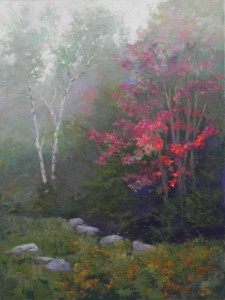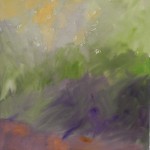Over the past three days I’ve been in the studio, while Jeanne Rossier Smith has been teaching a workshop of 18 members of the Maryland Pastel Society in the classroom that I normally teach in. It’s fun to be there at the same time and I want them to feel welcome at Artists and Makers. So I’ve had a lot of time to paint. Last fall I did a painting that I loved doing–Red Emerging. I put it on Facebook and sold it almost immediately! With that, I decided that I wanted to do it again larger so that I could spend more time on it and have the painting as well. I had purchased an 18 x 24 True Grit panel with this in mind so I was all set.
But when I looked at the size of the panel last week, it seemed awfully big! So I gave thought to turning it horizontally and adding other things. But when I went to do the painting, I realized that I wanted to keep it pretty much the way it was. I printed out a picture of sumac that I thought I might add on the left.
As with the first painting, I began with a totally abstract watercolor underpainting. I used a warm orange for the sky and tried to get the darks as rich as possible. For the bottom, I used a violet and then a deep warm brown on top of it. The underpainting worked well for me, providing color to work over, without worrying about the composition at this point.
The composition was a major concern with this painting. I had to keep it from being half and half. I tried putting the sumac in at the base of the birch tree, but I really didn’t like it! So I got rid of it and late in the game, lightly added the hint of a red tree just to the right of the birch in the background.
I had more foreground in this painting than in the first one, so I decided to do more with rocks. I had added some to the first but decided to add more and make them more prominent. I got rid of one and kept the others as visitors to the studio said that they liked them. Another compositional change was to raise the foreground on the left to push it back further and keep it from being too straight.
I had a great time with the background on the left side. I used various greens to indicate trees, going light as it went up and then put a light violet in. The violet really pushed it back. And in the area of leaves in the birch, I added a pale majenta into the green to further gray it. For the tree on the right, I used a lot of Blue Earth quinacrodone red–a cool red with a lot of grays that were just perfect. I also used my box of turquoise and their grays for the leaves. These pastels are so handy in a painting like this where the values and chroma are so important.
Jeanne was focusing her workshop on color–value, chroma and temperature. I realized that that was what this painting was all about!



Truly a beautiful painting!
Thanks Margaret, glad that you like it!
I’m a recent follower and I enjoy reading your process. I too use and underpainting.
It’s interesting when an artist such as you will doubt some of the steps in process along the way . Doubt is always there for me each step of the way, always hoping my puzzle will come together to a good painting despite years experience.
Love your work.
Thanks for your comment Sandi. Doubt is always part of the equation of doing a good painting, but as we get more experienced I think we gain confidence that we can pull it off! I have learned to trust my instincts, to look at a painting critically to see what it is I don’t like. If it keeps nagging at me, it has to be changed. In this painting, it was the large dark area between the trees and the overall composition. But I finally resolved those things to my liking.